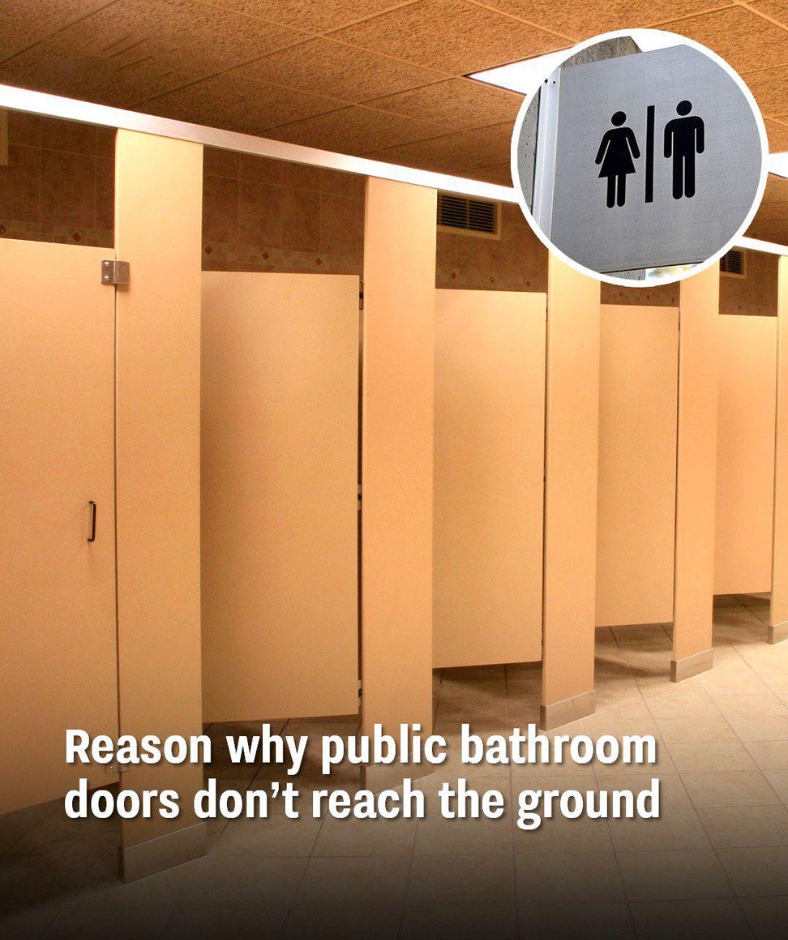Have you ever stopped to wonder why public restroom stall doors don’t extend all the way to the floor? While it might seem like a strange design decision, there’s a lot more thought behind it than meets the eye. This design choice, often overlooked, serves a variety of practical purposes that prioritize safety, hygiene, cost efficiency, and functionality. Let’s explore the key reasons behind this feature and why it makes so much sense.

One of the primary reasons public restroom doors don’t touch the floor is emergency access. Imagine a situation where someone inside a stall experiences a medical emergency or is otherwise incapacitated. The gap at the bottom of the door allows others to quickly see what’s happening and provide assistance if necessary. TikTok user MattypStories aptly explains, “If there’s ever an emergency, it would be pretty easy to see what happened and get the person some help.” In public spaces, where quick responses are essential, this small design choice can make a big difference in ensuring safety.
Another significant advantage is easier cleaning. Public restrooms experience heavy traffic, and maintaining cleanliness is a top priority. The gap at the bottom of the doors allows custodians to clean the floors more efficiently. Mops, brooms, and even pressure washers can easily reach under the doors without obstruction. Toilet fitting company ToiletPartitions emphasizes that this design streamlines the cleaning process, making it quicker and more effective while ensuring that hygiene standards are consistently met.
The decision to use raised doors also boils down to cost-effectiveness. Full-length doors are more expensive to manufacture and install, increasing the overall construction and maintenance costs of public restrooms. By opting for shorter doors, builders save on materials and reduce installation complexities. MattypStories points out, “It’s a lot cheaper to buy a door that has part of it cut off than the full door itself.” This cost-saving measure is particularly valuable for large facilities with multiple stalls, where even small reductions in cost can add up significantly.
Another practical benefit is improved air circulation. Proper ventilation is crucial in public restrooms to help dissipate unpleasant odors and maintain a fresh environment. The gap at the bottom of the doors promotes better airflow, allowing odors to escape more quickly. WC Portables explains, “The gap between the door and the floor provides a quick escape of the foul smell that was generated by previous users.” This seemingly minor detail contributes to a more comfortable experience for everyone using the facilities.
In addition to these practicalities, the design also plays a role in preventing misbehavior. Public restrooms can occasionally become sites of inappropriate activities. By reducing privacy, the open-bottom design acts as a deterrent, making it easier for others to detect and discourage such behavior. WC Portables notes, “Shorter doors help ensure the toilet queue flows and people refrain from exhibiting poor behavior due to the embarrassment of being spotted.” This added transparency helps promote a safer and more respectful environment.
The design also addresses the potential issue of door malfunctions. If a stall door’s lock jams or the door becomes stuck, the gap provides an easy way for someone to crawl out. This safety feature ensures that no one is trapped inside a stall without a way to escape. As one user mentioned, “If the door gets stuck, you can crawl out.” This added reassurance enhances the overall usability of public restrooms.
Another understated yet valuable feature of the gap is that it helps in indicating occupancy. Instead of awkwardly knocking on a door or attempting to open it only to find it occupied, people can simply glance at the floor to determine whether a stall is in use. ToiletPartitions explains, “Rather than having to knock on the door to see if a public bathroom is available, a gap at the end of the stall helps to determine if the stall is vacant or not.” This small design detail reduces misunderstandings and makes restroom use more efficient.
Interestingly, the reduced privacy provided by raised doors also encourages faster turnover. With less privacy, users are more likely to finish their business quickly, reducing wait times for others. WC Portables observes, “When individuals sense others can listen to their business that easily, they are prone to wrap up quickly.” This leads to a more efficient flow of users in high-traffic restrooms.
Lastly, the gap allows for easy access to supplies if needed. For example, if someone inside a stall runs out of toilet paper, it’s much easier for another person to pass it under the door. This feature ensures that minor inconveniences can be resolved without unnecessary frustration or embarrassment.
In conclusion, while the design of public restroom stall doors might seem unusual at first glance, it serves a wide range of practical purposes. From ensuring emergency access and facilitating cleaning to promoting air circulation, saving costs, and even encouraging faster restroom turnover, the raised door design is a well-thought-out solution to many challenges of managing public restrooms. The next time you encounter this design, you’ll have a newfound appreciation for the thoughtful considerations that went into it. It’s not just about looks—it’s about making restrooms safer, cleaner, and more efficient for everyone.





